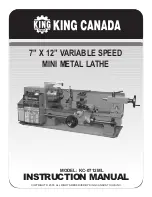
5. HEALTH & SAFETY INFORMATION
5.1 GENERAL SAFETY INSTRUCTIONS FOR POWER TOOL USE
When using any type of power tool there are steps that should be taken to make sure that
you, as the user, remain safe.
Common sense and a respect for the tool will help reduce the risk of injury.
Read the instruction manual fully.
Do not attempt any operation until you have read and
understood this manual.
Most important you must know how to safely start and stop this machine, especially in an
emergency.
Keep the work area tidy and clean.
Attempting to clear clutter from around the machine
during use will reduce your concentration. Mess on the floor creates a trip hazard. Any
liquid spilt on the floor could result in you slipping.
Find a suitable location.
If the machine is bench mounted; the location should provide good
natural light or artificial lighting as a replacement. Avoid damp and dust locations as it will
have a negative effect on the machine’s performance.
If the machine is portable; do not expose the tool to rain. In all cases do not operate power
tools near any flammable materials.
Beware of electric shock.
Avoid contact with earthed surfaces; because they can conduct
electricity if there is an electrical fault with the power tool. Always protect the power cable
and route it away from danger.
Keep bystanders away.
Children, onlookers and passers by must be restricted from entering
the work area for their own protection. The barrier must extend a suitable distance from the
tool user.
Unplug and house all power tools that are not in use.
A power tool should never be left
unattended while connected to the power supply. They must be housed in a suitable
location, away locked up and from children.
Do not overload or misuse the tool.
All tools are designed for a purpose and are limited to
what they are capable of doing. Do not attempt to use a power tool (or adapt it in any way)
for an application it is not designed for. Select a tool appropriate for the size of the job.
Overloading a tool will result in tool failure and user injury: This covers the use of
accessories.
Dress properly.
Loose clothing, long hair and jewellery are all dangerous because they can
become entangled in moving machinery: This can also result in parts of body being pulled
into the machine.
Clothing should be close fitted, with any long hair tired back and jewellery and neck ties
removed. Footwear must be fully enclosed and have a nonslip sole.
11. TROUBLESHOOTING
PROBLEM
PROBABLE CAUSE
SUGGESTED REMEDY
Motor will not run.
Headstock loose on bed.
Wood burns at tailstock end.
Fuse blown.
Defective on/off switch.
Defective switch cord.
Burned out motor.
Locking handle not tight.
Live centre too tight or not
lubricated.
Remove plug from power supply
and replace fuse.
Replace defective parts before
using lathe again.
Any attempt to repair this motor
may cause a hazard unless the
repair is done by a qualified
service technician.
Tighten locking handle.
Back of tailstock barrel and
lubricate live centre. See Basic
Lathe Operation “Spindle
Turning”
NOTE: Repairs should only be carried out by a qualified person.
23
6




























